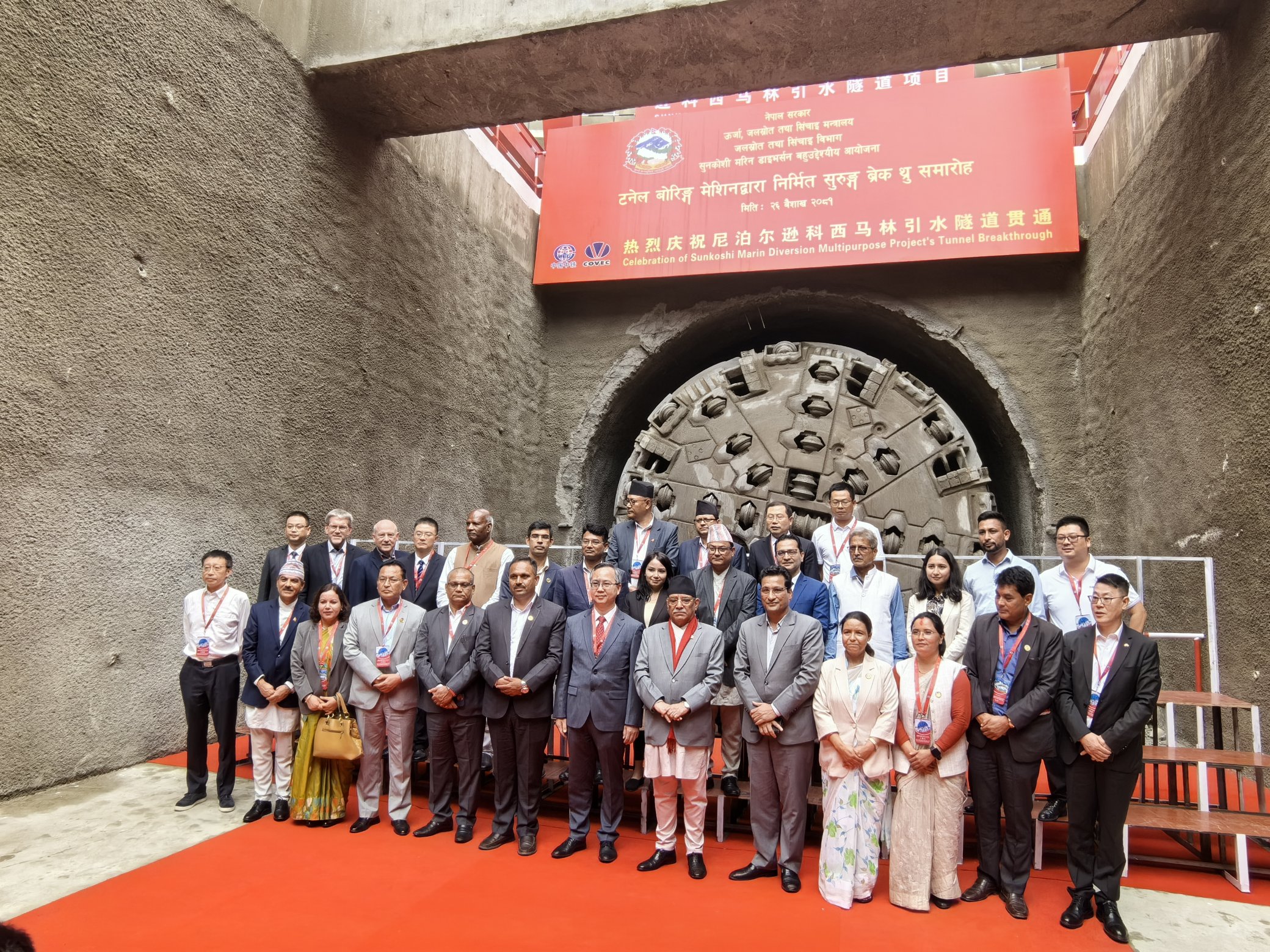KATHMANDU, May 8: The much-awaited Sunkoshi-Marin Diversion Multipurpose Project, which is expected to benefit large areas of land in southern plains of Nepal, has achieved a breakthrough of its tunnel construction.
Apart from generating 31.07 megawatts of electricity, the project is expected to provide irrigation facility to around 122,000 hectares of fertile lands in Dhanusha, Mahottari, Sarlahi, Rautahat and Bara districts throughout the year. The government has identified the Sunkoshi-Marin Diversion Project as a National Pride Project.
The construction of the final point of the 13.3-kilometre-long tunnel of the project has now been completed. The tunnel stretches from Kamalamai-2 Kusumtar to Sunkoshi-7 Kandhungri.
In an event organized on Wednesday, Prime Minister Pushpa Kamal Dahal initiated the breakthrough by pressing the Tunnel Boring Machine (TBM) switch. Speaking at the ceremony, Prime Minister Dahal said the project could help achieve sustainable growth of the national economy. He directed the authorities concerned to expedite the remaining works under the project on time.
Sunkoshi-Marin Diversion Project’s tunnel construction nears co...

 The then Prime Minister KP Sharma Oli had laid the foundation stone of the project on March 4, 2021. However, the construction was started only in October 2022, after 19 months of laying the foundation stone.
The then Prime Minister KP Sharma Oli had laid the foundation stone of the project on March 4, 2021. However, the construction was started only in October 2022, after 19 months of laying the foundation stone.
Mitra Baral, head of the Sunkoshi-Marin Diversion Multi-Purpose Project, said that the tunnel breakthrough was achieved one year ahead of the schedule. “The tunnel was successfully completed in 19 months, with an impressive daily progress of 72 meters,” he said.
According to Baral, tunnel excavation witnessed six brief interruptions during the excavation process, mainly due to dry landslides hindering the progress of installation of the TBM.
The project features a high-quality 5.5-meter diameter tunnel, with plans for constructing a 30-meter high and 158-meter long dam on the Sunkoshi River in Kandhungri. Water will be directed through the tunnel into the Marin River in Kusumtar, facilitating the generation of 31.07 megawatts of electricity from a 66-meter water drop.
The construction contract for the tunnel was awarded to the Chinese company China Overseas Engineering Group Co Ltd (COVEC), known for its previous tunnel construction work in the Bheri-Babai Diversion project. Baral said that COVEC undertook the contract for an undisclosed sum.
According to Baral, COVEC took the contract for Rs 10.568 billion only to dig tunnels in the project site. The total project cost is estimated at Rs 49.42 billion.

Speaking at the program, Chinese Ambassador to Nepal Chen Song expressed his gratification on the breakthrough more than one year ahead of the scheduled time. “It is truly national pride for Nepal,” the Chinese Envoy said. “122,000 hectares of land in the Southern Area of Nepal will be irrigated. A big thank you to Chinese contractors and Nepali technicians.”
 The program was also attended by the US Ambassador to Nepal Dean R. Thompson. “It was a great example of American technology being used to help improve access to water resources in Nepal. This tunnel, completed in nineteen months by Robbins’ tunnel-boring machine — eleven months ahead of schedule, demonstrates that Nepal can bring projects to a close not just on schedule, but ahead of schedule,” he wrote on X.
The program was also attended by the US Ambassador to Nepal Dean R. Thompson. “It was a great example of American technology being used to help improve access to water resources in Nepal. This tunnel, completed in nineteen months by Robbins’ tunnel-boring machine — eleven months ahead of schedule, demonstrates that Nepal can bring projects to a close not just on schedule, but ahead of schedule,” he wrote on X.
“We are proud of the role that American technology has played in delivering this successful result and look forward to more collaboration that benefits Nepal,” he wrote further.



_20240508123602.jpg)





























